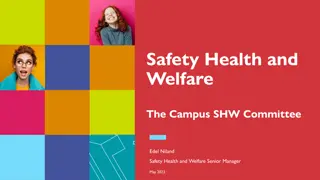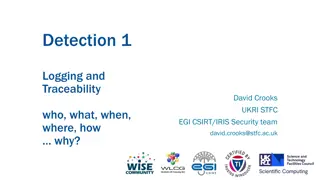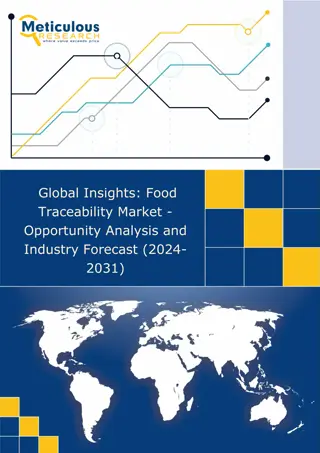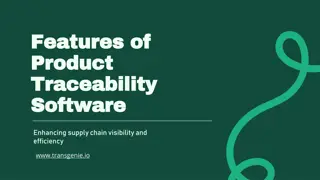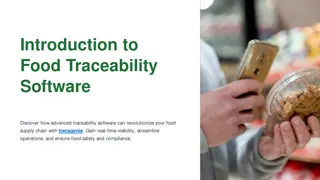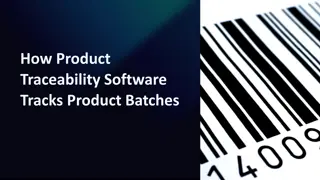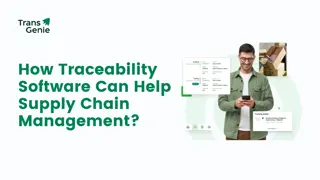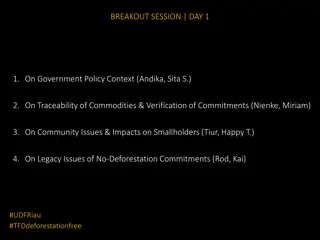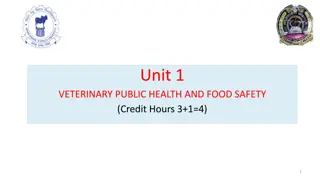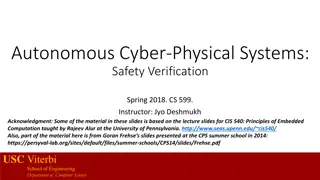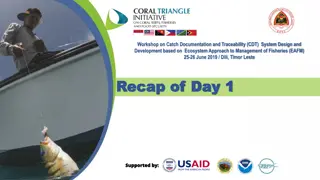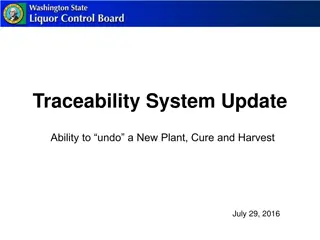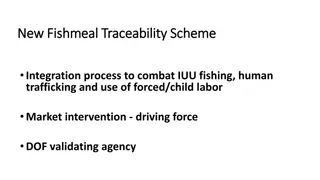Ensuring Food Safety: Traceability in Food Systems
In the world of increased foodborne illnesses and global food trade, the focus on traceability of food sources is crucial to containing outbreaks efficiently and cost-effectively. This guide discusses the importance of traceability, the technologies involved, and the balance between costs and benefits in implementing traceability systems.
Download Presentation

Please find below an Image/Link to download the presentation.
The content on the website is provided AS IS for your information and personal use only. It may not be sold, licensed, or shared on other websites without obtaining consent from the author. Download presentation by click this link. If you encounter any issues during the download, it is possible that the publisher has removed the file from their server.
E N D
Presentation Transcript
COMPLIMENTARY TEACHING MATERIALS MICROBIAL FOOD SAFETY A FOOD SYSTEMS APPROACH Charlene Wolf-Hall and William Nganje
Chapter 13: Cost and Benefits of Control Measures: Food Traceability COMPLIMENTARY TEACHING MATERIALS
Key Questions What is food traceability? What technologies do we use to track the flow of food and food risks? What is the role of traceability in mitigating the cost of food risks? How does the cost of traceability compare to its benefits? COMPLIMENTARY TEACHING MATERIALS
Introduction In the current climate of foodborne illnesses from pathogens and increased food trade around the globe, a major concern involves the actions taken by the industry and governmental agencies to contain or trace the source of current and future outbreaks in a timely, targeted, and cost-effective manner. The duration and cost of trace back for food imports may be even more problematic. COMPLIMENTARY TEACHING MATERIALS
Delays in Recall To address these concerns the US Food and Drug Administration (FDA) is proposing a mandatory electronic traceability format for each point along the supply chain within 24 hours of an FDA request. The proposed rule suggests that, despite the considerable costs of implementing electronic traceability systems, several benefits outweigh the cost. COMPLIMENTARY TEACHING MATERIALS
Traceability and Supply Network Structure Complex network structure is one potential reason why firms tend to delay investments in rapid response trace back systems. The California leafy greens supply network is an ideal setting for a case study of this type, because its structure is likely to facilitate implementation of traceability systems. COMPLIMENTARY TEACHING MATERIALS
Tracing Food Risks The entities depicted in the Figure 13.1 (such as growers fields, packing facilities, distributors and retailers) are arranged in chains that are only sparsely linked to each other. In a network of this type the number of paths through the network is relatively small. COMPLIMENTARY TEACHING MATERIALS
Figure 13.1. A typical leafy greens supply network COMPLIMENTARY TEACHING MATERIALS
Case Study: Traceability Systems within the LGMA The LGMA does not require members to implement specific systems. Although it encourages the use of tracking systems based on RFID, no specific technology or information system is mandated by the agreement itself. Instead the agreement makes reference to federal law the only explicit specification for compliance with the agreement. COMPLIMENTARY TEACHING MATERIALS
The LGMA audit checklists specific requirements are given as follows (LGMA, 2008): 1. Is an up to date growers list with contact and location information available for review? 2. Is the handler in compliance with the registration requirement of The Public Health Security and Bioterrorism Preparedness and Response Act of 2002? 3. transporter source? b. Does it enable identification of immediate non- transporter subsequent recipient? Does the Handler have a traceability process? a. Does it enable identification of immediate non- COMPLIMENTARY TEACHING MATERIALS
Cost of the LGMA Traceability System Adhering to LGMA standards and meeting the audit compliance requirements can be costly for members. Paggi (2008) noted that LGMA compliance costs range between US$210 and US$260 per acre. COMPLIMENTARY TEACHING MATERIALS
Costs for two technologies (i.e. barcode and RFID) were estimated for representative firms by size, and then aggregated to obtain the estimated industry costs. Each system s costs, which included both variable and fixed costs were computed for representative firms of three sizes measured in shipment volume (1 = 0 100,000 pounds; 2 = 100,001 999,999 pounds; 3 = 1 million or more pounds). COMPLIMENTARY TEACHING MATERIALS
In estimating cost and technology configurations for traceability systems, it should be noted that when commingling is prevalent (for loosely coupled, linear and complex systems), then multiple barcodes would be needed. Barcode technology was determined to be the least expensive in a tightly coupled, linear system, such as spinach. COMPLIMENTARY TEACHING MATERIALS
Analysis of CostsBenefits of LGMA Traceability System The 2006 California spinach E. coli outbreak is mainly relevant for the analysis of the supply chains' losses and the costs associated with fresh product recalls. This is especially the case considering that each partner of the supply chain is likely to be negatively affected by an outbreak. Due to the problems associated with traceability, the contaminated spinach was traced to National Selected Foods as the packer. COMPLIMENTARY TEACHING MATERIALS
The estimated benefits of having a traceability system in place will be reflected in the reduction of costs due to contamination. We estimate the failure costs associated with the 2006 E. coli O157:H7 outbreak based on the US spinach industry losses and the total costs linked to the product recall to be approximately US$129 million USD. COMPLIMENTARY TEACHING MATERIALS
The total volume of contaminated product that caused the outbreak and the product recalls were approximately 15,750 pounds of bagged Dole baby spinach, which are identified by the code P227A. The code indicated that the spinach was produced at Natural Selection s south plant (P) on the 227th day of the year (August 15) during the first of two shifts (A) (Weise and Schmit, 2007). Losses due to false alarm for commingled products or spinach produce out of California could have been avoided if trace back were rapid and technology could lead to more targeted recall. COMPLIMENTARY TEACHING MATERIALS
Assumptions to Estimate Benefits This assumption is realistic as the survey by Tootelian (2007) revealed that about 60.5% of those who had paper trail or barcode traceability systems expanded their systems. This expansion should include better electronic tracking systems. The assumptions of increased use of electronic systems and availability of linking the electronic information across agents in the food system are consistent with the program recommended by the panel for 24-hour electronic data availability (IFT, 2009). COMPLIMENTARY TEACHING MATERIALS
Food Policy Implications As networks become more complex, traceability systems must follow suit. Effective trace back/forward in complex tightly coupled systems may depend on the presence of large, powerful players such as global food companies or global retailers in the network. COMPLIMENTARY TEACHING MATERIALS
Since controlling a complex network requires information- intensive relationships with a greater variety of counterparties, there is a risk of information overload for the controlling firm. In tightly coupled networks, reducing complexity and assigning an enforcement role to a central player would make traceability systems possible, but only at a high cost in terms of system resources, data quality and the opportunity costs of committing to a smaller supplier base for any product. COMPLIMENTARY TEACHING MATERIALS
Summary In a loosely coupled complex network, we think solutions are limited to very simple logistics approaches similar to the one deployed by the LGMA. The problem in these networks is the absence of a central player, which suggests that government intervention, perhaps on an international scale, will be necessary. It is also possible that solutions will emerge from technology suppliers. Since the implementation of the LGMA and its traceability system there have been several timely interventions and fewer recalls, mostly voluntary lower class recall. This case makes its primary contribution to the goal of greater traceability by trying to show how the conditions that enable or impede traceability emerge from supply network structure. This case also suggests that investments in rapid response, targeted trace back systems could be cost-effective by minimizing trace back response rates. COMPLIMENTARY TEACHING MATERIALS
THANK YOU Name: Charlene Wolf-Hall & William Nganje Email: charlene.hall@ndsu.edu & William.Nganje@ndsu.edu COMPLIMENTARY TEACHING MATERIALS













